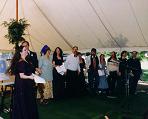"This is a Mummers’ play I wrote": Part 3 - Mumming Skits
Mumming SkitsMumming skits form the largest of group of scripts in the study collection. These are plays prepared for a single performance, although often at an annual event such as a Christmas party or ceilidh, or some other recurrent event such as a wedding. The plays acted at these events may always use a mumming play format, or mumming plays may be just one of several styles that are employed. However, whatever the custom, fresh scripts are composed for each occasion. The motivation is to provide entertainment, and the plays are often satirical, targeting national, organisational or family politics. They therefore portray or allude to topical characters and events, controversies and so on. Most of the text is freshly composed, but a few traditional speeches or formulae are usually included, as are stock characters such as a doctor. In addition, they frequently incorporate jingles, catchphrases, and similar allusions drawn from the mass media, often as parody. Example Mumming Skits
|
Case Study - The Cambridge-Somerville Wedding PlaysIn the USA, one social group with links to the Cambridge and Somerville area of Massachusetts has taken to performing mummers' skits at wedding receptions whenever one of them gets married. Or, as one of the plays says itself: "It seems there's a wedding here, and no-one gets away Many of the participants have studied or taught at the local universities, notably Harvard and MIT. Those that have moved away from the area have taken the new tradition with them, with weddings providing an opportunity for a "gathering of the clan". A large proportion of the participents are highly qualified and are high fliers in their chosen professions. Additionally, many are also members of folk dance groups and choirs. Usefully, one of the participants - Lenore Cowen has gathered the scripts of ten plays on her website (L.Cowen, no date). In addition to the scripts she also gives an account of how they are organised, and adds her own analysis of what characterises the Cambridge-Somerville tradition. The plays are prepared by committee under a cloak of secrecy, since in principle they are supposed to be a surprise entertainment for the bride and groom. As people are geographically dispersed, draft scripts and amendments bounce around the group by email. Themes from the lives of the bride and groom are woven into the plays, along with the traditional death and revival and other motifs. The background of the group also features in the plays. Many of the actors are doctors - PhDs if not actual medics - and these are cast accordingly. Indeed there may be several doctors either serially or together, and in one case, the fathers of both the bride and groom, who happened to be medics, were roped into the play at the last minute. Also, there are often groups rather than individual characters - for instance a group of dancers - who speak and act and even die in unison. |
|||||||||||||||||||||||||||||
 Fig.2 - Wedding Play Click on thumbnail to view full-size |
|||||||||||||||||||||||||||||
|
According to Lenore Cowen the main features of the plays are as follows:
She also provides lists of motifs, from which the following have been extracted:
These lists illustrate my own observations that the death is always non-violent - there is no fight - and the revival is usually non-medical, unless one allows the pharmacological effects of strong coffee. The scripts are written in rhyme - mostly couplets. Almost no lines are taken from traditional mumming plays, but characters do introduce themselves with the traditional formula "In comes I". No other formulaic speeches are used. On the other hand, the following new set of Doctor's lines appears to have become traditional for this group.
The above speeches are composite, and typical of lines found in most of the Cambridge-Somerville texts. The humour here appears to be self-deprecatory. The performers and audience members are mostly experts, consultants and other professionals. These lines seem to acknowledge the common complaint that when experts are brought in to examine a problem, their reports often merely state what was known already, or what could have been determined by anyone with a bit of common sense, and do not contribute towards a solution. |
|||||||||||||||||||||||||||||